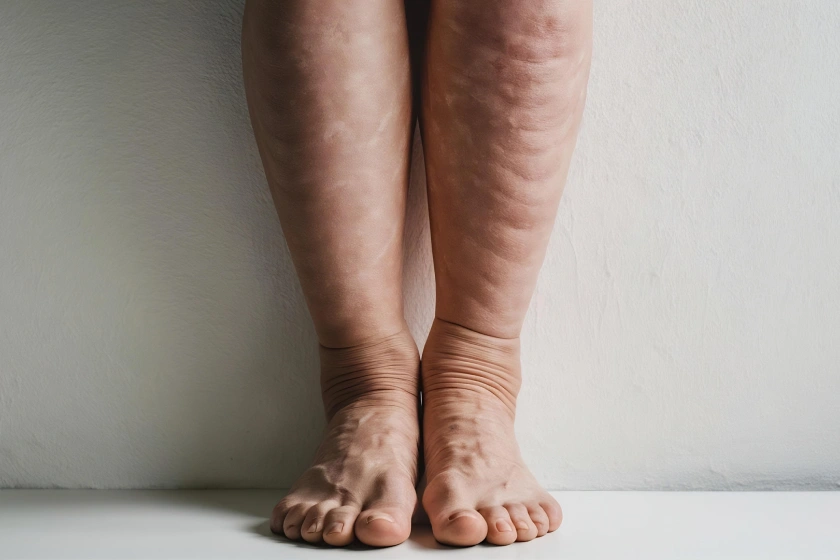
A middle-aged man walks into a clinic complaining of heavy, swollen legs that have been bothering him for months. His shoes no longer fit comfortably, and each step feels like carrying a weight he cannot shake off.
When examined, the swelling is found to be more than just water retention. His blood sugar levels are high, and the veins in his legs show signs of poor circulation. For millions of people in India living with diabetes, this story sounds all too familiar.
Swollen legs in diabetic patients are not just an inconvenience or a passing symptom. They are often the first visible sign that something deeper is wrong with the body’s circulation or fluid balance.
In India, where diabetes is growing at an alarming rate, more than one in ten adults faces complications related to poor blood flow and nerve damage. Swelling of the legs may look harmless, but in diabetic patients, it can signal underlying problems in the veins, kidneys, or heart.
Why Do Diabetic Patients Get Swollen Legs?
Swelling in the legs, known medically as edema, happens when fluid accumulates in the tissues of the lower limbs. For diabetic patients, several interconnected factors contribute to this condition. The most common cause is poor circulation. High blood sugar levels over time damage the inner lining of blood vessels, making them less efficient at transporting blood. When the veins in the legs struggle to push blood back toward the heart, fluid begins to leak out into the surrounding tissues, causing visible swelling.
Another common cause is diabetic nephropathy, or kidney disease, which is one of the most frequent long-term complications of diabetes. Healthy kidneys maintain a delicate balance of salt and water in the body. When they become damaged, they cannot filter waste or excess fluid effectively, leading to fluid retention and swelling in the legs and feet.
Nerve damage, known as diabetic neuropathy, can also play a role. When nerves in the legs are affected, patients may not feel pain or discomfort, allowing swelling or small injuries to go unnoticed until they become severe. Certain medications used to control blood pressure or blood sugar may also cause mild swelling as a side effect.
In some cases, swelling in diabetic patients may also point to heart problems such as congestive heart failure. This happens when the heart is unable to pump blood effectively, causing fluid to accumulate in the lower limbs. Therefore, identifying the exact reason for swollen legs in diabetics requires careful medical evaluation and sometimes multiple tests.
When to Worry: Signs It’s More Than Just Swelling
Not all swelling is dangerous, but it is important to know when it becomes a warning sign of a more serious condition. Diabetic patients should be alert to changes in the appearance or sensation of their legs and feet. Some symptoms that need immediate medical attention include:
- Swelling that appears suddenly or increases rapidly over a few days.
- Swelling is more prominent in one leg than the other.
- Redness, warmth, or tenderness in the swollen area
- Shiny, tight, or discolored skin that feels stretched
- Open wounds, ulcers, or fluid discharge from the skin
- Numbness, tingling, or pain in the legs or feet
- Shortness of breath or fatigue occurring with swelling
These symptoms could indicate underlying vascular problems such as deep vein thrombosis, infection, or heart or kidney complications. Early intervention can prevent these issues from worsening or leading to permanent damage.
Effective Treatment Options
The first step in treating swollen legs in diabetic patients is identifying the cause. A vascular surgeon or diabetes specialist will conduct a detailed examination and may order investigations like Doppler ultrasound, kidney function tests, or echocardiography to evaluate circulation, heart health, and kidney performance.
Once the cause is established, a combination of lifestyle measures, medical treatment, and specialized therapies can be used to control swelling and prevent recurrence.
Lifestyle Changes
Lifestyle modification is the foundation of all treatment plans for swollen legs in diabetics. Regular physical activity, such as walking or swimming, improves blood circulation and prevents fluid from collecting in the lower limbs. Patients are advised to elevate their legs several times a day to help blood flow back toward the heart.
Diet also plays a major role. Reducing salt intake helps prevent the body from retaining excess water. Maintaining blood sugar levels within the target range prevents further damage to blood vessels. Diabetic patients should avoid sitting or standing for long hours without movement and should wear comfortable footwear that does not constrict circulation.
Compression Therapy
Compression stockings are one of the most effective non-invasive treatments for chronic leg swelling. These stockings apply gradual pressure from the ankles upward, which helps push fluid back into the bloodstream and prevents pooling. However, diabetics should only use them under medical supervision. If blood flow to the legs is already compromised due to arterial disease, improper use of compression stockings can worsen symptoms.
Medications
In some cases, medicines may be necessary to control swelling. Diuretics, commonly known as water pills, help the body eliminate excess fluid through urine. Antibiotics are prescribed if an infection is suspected. Patients with poor circulation may benefit from medications that improve blood flow and strengthen vein walls. It is important to follow medical advice closely and not take over-the-counter medicines without consulting a doctor, as some drugs may affect kidney or heart function.
Home Remedies That May Help
Alongside medical treatment, certain home-based remedies can help relieve discomfort. Applying a cold compress can reduce inflammation and provide temporary relief. Gentle leg massages can improve circulation, but only if there are no open sores or ulcers.
Staying well hydrated ensures the body can flush out extra sodium, which otherwise contributes to fluid retention. Simple exercises such as ankle circles, leg raises, and foot flexing can also keep circulation active even while sitting.
When to See a Doctor
Diabetic patients should not ignore swelling that persists for more than a few days or keeps coming back. If the swelling is associated with pain, redness, fever, or wounds that do not heal, it is time to see a specialist. A vascular surgeon or doctor for swollen legs can determine whether the problem is due to circulation, kidney, or heart issues and recommend the right treatment. Regular checkups are essential for all diabetic patients, even if the swelling appears mild, as early diagnosis can prevent serious complications like ulcers and gangrene.
Conclusion
Swollen legs in diabetic patients are often the body’s way of sending an early warning signal. They may start as a minor swelling or heaviness, but can quickly progress into more serious problems if ignored. Diabetes affects the entire circulatory system, and leg swelling is a visible sign of how blood vessels and organs like the heart and kidneys are coping with the condition.
The key to managing this problem lies in early diagnosis, consistent blood sugar control, and proper medical guidance. Adopting a healthy lifestyle, staying active, maintaining an appropriate diet, and avoiding long periods of inactivity are simple yet powerful ways to prevent swelling. Medical treatments such as compression therapy and medication can bring lasting relief when combined with these preventive steps.
At advanced vascular centers, modern diagnostic tools and personalized treatment plans have made it possible to control swelling effectively and protect leg health in diabetic patients. Dr. Sumit Kapadia, an experienced vascular surgeon, specializes in managing diabetic leg complications through evidence-based care and minimally invasive treatments. His approach focuses not only on reducing swelling but also on preventing its recurrence by addressing the root cause.
If you ever experience sudden swelling, coldness, or numbness in a limb after an injury, seek immediate help from an expert.
Dr. Sumit Kapadia, one of India’s most trusted vascular and endovascular surgeons, has years of experience managing complex trauma cases. His advanced vascular trauma clinic offers comprehensive evaluation, emergency surgery, and long-term rehabilitation to ensure patients recover completely and regain normal function.
With timely diagnosis and expert intervention, most vascular injuries can be treated successfully, saving both limbs and lives.
Frequently Asked Questions
Swelling in diabetic patients occurs due to poor circulation, nerve damage, kidney problems, or heart-related conditions that cause fluid retention.
Yes, persistent swelling can indicate deeper vascular issues or infections that, if left untreated, may lead to ulcers or tissue damage.
Yes, prolonged high blood sugar damages blood vessels, resulting in fluid accumulation and reduced blood flow in the legs.
Exercise, leg elevation, compression therapy, controlled blood sugar, and reduced salt intake can all help manage swelling.
Yes, when kidney function declines, excess fluid builds up in the body, leading to swelling in the feet and legs.

Dr. Sumit Kapadia
MBBS, MS, MRCS, DNB-Fellow



